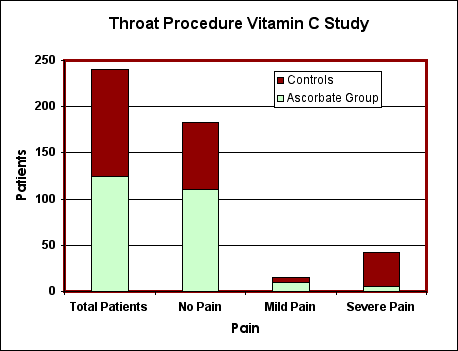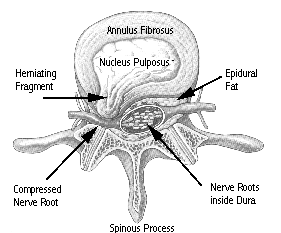The stress on the back requires optimum nutrition
Chronic Vitamin C deficiency may be the leading cause of disc herniations.
Musculo-skeletal conditions afflict millions, some no more than a nuisance, some crippled for life. Cforyourself presents the relationship between the chronic forms of these problems and vitamin C. As is the case with most all chronic conditions, nutrition plays a large role.
Almost everyone experiences some painful recognition of the complex and difficult job our back performs. The vertebra, stacked on each other with cushioning discs in-between, supporting our ability to stand and move and also provide a protected environment for our nervous systems main pathway, or if you’ll excuse the expression, the nervous systems “backbone”.
From a slight strain to Osteoporosis, chronic back conditions afflict almost everyone on the planet at some time during their lifetime. I had a herniated disc myself in 1991 (before I started taking vitamin C). The Decade of Bone and Joint project gives this background information
- Joint diseases account for half of all chronic conditions in persons aged 65 and older
- Back pain is the second leading cause of sick leave
- The number of fragility fractures in the elderly has increased dramatically over the past decade (almost doubled) and an estimated 40% of all women over 50, will suffer from a fragility fracture
- The number of severe injuries caused by traffic accidents and war injuries have led to a tremendous demand for preventive and restorative help. It is anticipated that 25% of health expenditure of developing countries will be spent on trauma related care by the year 2010.
- Crippling diseases and deformities continue to deprive children of their normal development.
Occasional Pain and Stiffness
As mentioned above, your back is a complex set of vertebra and discs. The constant stresses placed on this system daily affect its proper alignment. This is why I am a believer in chiropractic, the area of the medical community that deals with the mechanics of the spine. A very informative site about chiropractic is At YourSpine.
Everybody pulls a muscle. Everybody sometimes gets the pain and stiffness the day after exercise. Indeed, the bodybuilding community uses the phrase “No pain, No gain” to describe the consequent pain and stiffness associated with the exertion levels necessary to build and maintain muscle. If you don’t have any pain or soreness the next day, you didn’t train hard enough. I say “Feel pain, Refrain!”. The muscles of our back, particularly the lower back, are especially susceptible to this exertion and resultant pain.
The Vitamin C Connection discusses the effectiveness of vitamin C on muscle and back pain. I.H. Syed in London describes his experience with C and muscle pain an stiffness:
“that muscle stiffness and pain which arises after exercise or an unaccustomed work could be prevented and treated by taking massive doses of ascorbic acid”. His treatment was 500mg before exercise and 400mg afterward, along with plenty of fluids. If discomfort still occurs, Syed recommends another 400mg in the morning and one or two doses of 200mg every two hours if required.
Another study looked at patients undergoing procedures involving instruments placed drown the throat. These procedures produce trauma to the muscles lining the throat, causing pain and soreness. The results are shown below. The most statistically significant result is the difference in the number of patients reporting “severe pain”, 37 versus 5.

Vitamin C may be effective for several reasons. The most obvious is in the development of collagen which is the foundation of the extra-cellular matrix, the glue that allows cells to form tissues. This extra-cellular matrix is dependent on sufficient vitamin C for its proper formation. This is particularly true of tendons, ligaments, intervertebral discs and other tissues subject to mechanical stress (this is why there is such a strong link between C and atherosclerosis). Adequate C will produce better muscle tissues in the first place and will also aid in their healing when they are damaged. The damage from exercise also produces toxic waste materials. Vitamin C may aid in the quenching of these toxic materials and also may aid in their elimination due to C’s diuretic properties.
Low-Back Pain
Low-back pain that comes occasionally is usually associated with strain. This is as discussed above. The Vitamin C Connection discusses the experience of James Greenwood, Clinical Professor of Neurosurgery at Baylor University’s College of Medicine in the 1960’s reported 250mg of ascorbic acid four times a day for patients with vertebral-disc problems gave considerable relief. If C supplementation was discontinued, muscle soreness and pain returned. Summarizing his experience with more than 500 patients, Dr. Greenwood said ” a significant percentage with early disk lesions were able to avoid surgery.” and “the number of reoperations on the same patient for recurrence at the same level or a new disk lesion at a different level was greatly reduced.”
This positive experience is due to the vitamin C building up the spinal disc as discussed below.
Disc Herniations
A spinal disc is somewhat like a filled doughnut. As shown in the drawing below (please visit the Alabama Back Institute, source of the drawing below for more information), the exterior portion, called Annulus Fibrosus is a tough, grissel-like material. Inside this is a much softer cushioning substance called the Nucleus Pulposus. Due to the wear and tear that these discs endure combined with the loss of toughness of the exterior, AF, due to chronic vitamin C deficiency, a hole may develop allowing the soft interior NP substance to be pushed out. The drawing shows how this can happen. When this happens and the squished out portion touches the nerve as shown, pain results and let me tell you it can be excruciating!

Vitamin C is required for the proper formation of the ground substance or extra-cellular matrix that gives tissues their structural integrity (see What C Does). The constant stress on the spinal disc requires that tissues of the Annulus Fibrosus be constantly replaced. The name of this structure, Fibrosus, references the structural fibers that make it tough. These fibers absolutely do not form properly without adequate vitamin C. I read about a study (I can’t seem to find it) that concluded that chronic vitamin C deficiency was the leading cause of disc herniations.
Osteoporosis
Osteoporosis, meaning “porous bones” is a widespread and often discussed chronic condition. It is odd that we would logically think of bones as static once they are formed; that nutrition would not be able to affect them and yet we accept the contradiction to this that calcium supplementation can help prevent osteoporosis. And indeed nutrition is the major underlying cause of osteoporosis.
In their paper Vitamin C, Collagen Biosynthesis, and Aging published in Vitamin C in Health and Disease, Charlotte Phillips of the University of Missouri and Heather Yeowell of the Duke University Medical Center write:
“Bone is not a static organ; it is continuously being remodeled (repaired and replaced, Ed.) by the removal of old and damaged bone by osteoclasts and the formation of new bone by osteoblasts”.
Indeed, 6 to 12 percent of an adults skeleton is replaced every year. It is obvious that the proper raw materials in adequate quantities be available to remake high quality bone. Calcium is important and it’s supplementation should include about 50% as much magnesium as calcium. Combination tablets are readily available. What is not considered is vitamin C. As we discuss over and over, vitamin C is essential for the proper formation of collagen. This collagen forms the extra-cellular matrix of bone as well as other tissues. Phillips and Yeowell conclude their paper:
“This chapter demonstrates the important role that ascorbic acid plays in the production and maintenance of healthy connective tissue and its relationship to aging. Studies by several investigators and laboratories, looking at many different cell lines, tissues, and whole animals as well as humans, have clearly demonstrated that ascorbic acid is essential to maintaining healthy functioning connective tissue throughout the aging process.”
Conclusion
Almost all chronic back problems have a relationship to vitamin C deficiency due to C’s requirement for proper tissue generation. Most soreness and pain associated with exercise, most disc herniations and even osteoporosis could be all but eliminated with proper nutrition of which vitamin C is the foundation.
